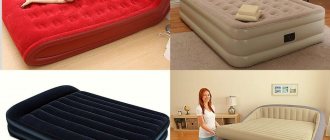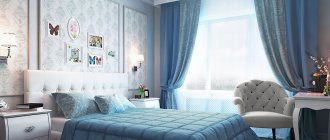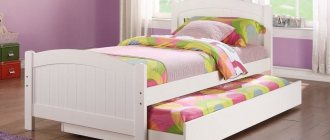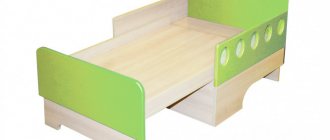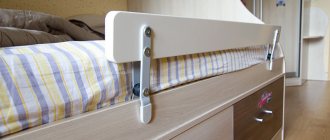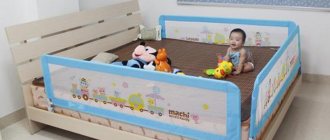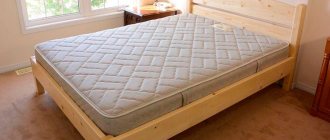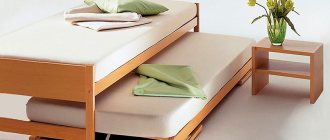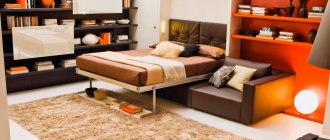When decorating a children's room, parents are guided by considerations of practicality, safety and visual appeal. Even when choosing such a thing as a bedspread for a child’s bed, there are some nuances. Accessories for your son's room are no less important than for your daughter's bedroom.
When decorating a children's room, parents are guided by considerations of practicality, safety and visual appeal.
Silk and satin bedspreads look chic in mom's room, but are inappropriate and uncomfortable on a child's bed.
The color range of children's bedspreads for boys is wide and varied.
Basic requirements for children's textiles
The choice of products for children, be it toys, clothing or bedding, has its own nuances. Characteristics such as quality, convenience, and safety come to the fore. Even the most expensive and beautiful product that does not meet these requirements is not worth purchasing.
Often the role of a bedspread in a nursery is not limited to decorative function and protection of bed linen from dirt. Children play on the bed, sit or lie on it, read books, have a snack. In a baby's room, the blanket can be moved to the floor, turning into a play mat; older children begin to use it to build houses and shelters. It can be used as a blanket during a short afternoon rest or wrapped up in the cold season while watching TV.
The versatility of the bedspread and its use by children impose the following requirements on the material:
- non-toxic;
- breathability;
- hygroscopicity;
- ease of care;
- hypoallergenic;
- should not be electrified;
- strength;
- pleasant tactile sensations.
Bedspreads can be made from one type of material or include filler, most often padding polyester. Quilted bedspreads with filling are often stronger and more attractive in appearance, but are bulkier and more expensive.
Functions
Let's find out why you need a blanket for a children's bed.
Firstly, the blanket protects the baby's bedding from dirt and dust. During the day, the child can play and even run around the bed. It is much more practical and safer when he does this on the bedspread, and not directly on the bed linen.
The bedspread decorates the room. Modern textile products for children are so decorative and bright that their mere presence lifts the mood and charges them with positive energy.
The cover, if it is soft, can also be used as a blanket if necessary. It is especially suitable for a child’s daytime nap if he has not yet reached the appropriate age.
A rug can also replace a blanket if a child wants to play on a cool floor.
Fabric color and texture
In most rooms, the bed takes up a significant part of the space, which means the bedspread will become an essential part of the overall interior. But while adults select bedspreads to match the decor, children often rely only on their own taste. Sometimes, especially if they don’t have their own room and the bed is in their parents’ bedroom, the chosen bedspread can be very different from the overall design, causing protests from parents. Conflicts can be avoided in two ways:
- use a double-sided blanket. In this case, you can always turn the product over to soften the garish contrast;
- make a color accent in the area where the bed is, matching the bedspread: a small rug, a picture on the wall.
The texture of the fabric for the bedspread can be smooth or printed. However, it is worth remembering: satin bedspreads, popular in the design of adult bedrooms, are not suitable for a child’s room. It is better to choose products made from natural fabrics with a small content of synthetic fibers. Thanks to this, the product will wrinkle less and last longer. What is important for mothers, a small addition of artificial fibers will also make the bedspread easier to care for, it is easier to wash, and it dries faster.
In the production of bedspreads the following are used:
- fleece - this inexpensive material is deservedly popular. It comes in different colors, soft and pleasant to the touch. Absorbs moisture well and warms. But the material is not the most natural and accumulates static electricity;
- cotton is a natural eco-friendly material. It is inexpensive, has good air permeability, and has a large selection of colors. However, it wrinkles a lot, gets dirty quickly, and is not very durable. Most often, cotton bedspreads are used for newborn cribs, since for this age durability is not required due to the short period of use of things, but safety comes first;
- wool - such bedspreads look expensive and noble. They are natural, which means they absorb moisture and allow air to pass through. At the same time, wool can prick delicate baby skin and is difficult to wash. Small particles can enter the respiratory tract and cause allergies over time;
- satin is a dense natural fabric. Satin bedspreads hold their shape well and retain an attractive appearance for a long time. But this fabric is quite slippery, which the child may not like;
- tapestry is a beautiful, expensive option, however, it is not very suitable for a nursery, since it serves mainly a decorative function;
- microfiber - although this fabric allows air to pass through well and absorbs moisture, it is not recommended to use bedspreads made from it in the room of small children. It becomes highly electrified and accumulates dust, which can cause allergies. However, in the room of older children, blankets made of such fabric are acceptable. They do not wrinkle or roll, so the bedspreads retain their appearance for a long time.
When choosing a bedspread material for a nursery, you need to take into account the age of the child and the method of using the bedspread. The younger the age, the more natural the composition should be. If the bedspread is used only for its intended purpose, that is, it covers the bed during the daytime and protects the bed linen from contamination, the materials can be any. However, experience shows that the scope of application of coverings for children is much wider. Even if it is not used for play, children often sit or lie on the blanket during the day, covering themselves with it when they decide to take a nap or when they are cold. Therefore, there is no point in buying bedspreads made from expensive fabrics - they will not last long, and the child’s reluctance to handle the product with care can cause conflicts with parents. Highly electrifying material will be uncomfortable for the child.
A children's bedspread is unlikely to be used for its intended purpose for a long time: children grow, they require new, more spacious beds, for which the old blanket will be small. At the same time, due to active use, it will probably require frequent washing. Therefore, when choosing a material, you should take into account ease of maintenance and safety.
Tapestry
Microfiber
Satin
Fleece
Cotton
Wool
Ideas for decorating a children's bedroom
There are no strict canons for decorating a bed, but in order to establish yourself as a housewife with good taste and instill in your child a sense of style, you should adhere to a number of simple rules:
- Determine for yourself whether the bedspread will blend into the overall interior ensemble or become a bright accent in the decor of the room;
- For a room in country or Provence style, the Handmade bedspread model, made using a patchwork technique or crocheted from bulky yarn, is ideal;
- For an adult, practicality comes first, and for a child, visual appeal comes first. Younger children will like bedspreads with plot drawings from their favorite cartoons, and teenage children will like abstract shapes, geometric shapes, retro cars, city style and tartan;
- When choosing interior items for a child’s room, it is better to take into account his interests and wishes. So that the little person feels comfortable and calm in it;
- An excellent option for a nursery is a double-sided bedspread; it not only lasts longer, but can also be used to add a fresh note to the decor of the room. By choosing 2 sets of curtains to match different sides of the bedspread, you can periodically change the interior of the nursery
- Silk and satin bedspreads look chic in mom's room, but are inappropriate and uncomfortable on a child's bed.
The best blanket material for a newborn is natural flannel or flannel.
But all-cotton fabrics wrinkle easily, so the best option may be cotton with a small percentage of artificial fiber; it holds its shape and is easier to wash.
For a room in country or Provence style, the Handmade bedspread model, made using a patchwork technique or crocheted from bulky yarn, is ideal.
Size chart
The size of the bedspread depends on the size of the bed in which the child sleeps. As a rule, babies sleep in special cribs that have sides, so there is no point in choosing a bedspread with a large margin around the edges. For this age, it will be enough to buy or sew a product measuring 70-80 cm in width and 110-120 cm in length.
For a preschooler's bed, a blanket measuring 110x140 cm is suitable. For a teenager, the size of the blanket is no less than 140x220 cm and depends on the size of the bed.
Typically, the size of the bedspread is selected so as to cover the mattress, hanging over the edges. How long the free edge will be depends on the person’s preferences, but for a small child’s bedroom you should not choose a bedspread that hangs to the floor. Firstly, it collects dust more strongly, and secondly, the baby will trip over it. For older children there are no such restrictions; it all depends on the tastes of the parents and the child himself.
The length of the allowances is also affected by the presence of the backrest and sides of the bed. It is clear that on their part there is no point in making large allowances; a few centimeters are enough so that the bedspread can be tucked in over the edges. Those who don't like the look of fabric hanging down the sides of the bed can choose bedspreads with elastic. In this case, the dimensions of the bedspread will coincide with the dimensions of the bed, and the product itself will be securely fixed and will not crumple or fall.
Today, the market offers products of both domestic and foreign origin. The Russian size chart differs from the European one. But when choosing a bedspread, these differences are less significant than when buying bed linen, since greater accuracy of matching sizes is not required here. Therefore, you should focus primarily on the parameters of the child’s bed.
Design themes taking into account the age and gender of the child
Today, the choice of colors offered by manufacturers can satisfy people with a wide variety of tastes. When choosing the color and pattern of bedspreads for children, they are guided by the age and gender of the child. The older the child gets, the more it is necessary to take into account his tastes and preferences.
At the same time, we must not forget about the interior - it’s good if the bedspread fits into it.
Psychologists recommend choosing bedspreads in soft pastel shades for babies’ cribs, because bright colors will have an exciting effect on the child. When choosing shades for a children's bedspread, pink, peach, and milky tones are traditionally preferred for girls; for boys, blue, light blue, and coffee colors are chosen. Delicate beige, green, yellow shades are universal.
As the child ages, he begins to like bright colors. Preschoolers and primary schoolchildren enjoy surrounding themselves with heroes of their favorite cartoons and fairy tales. Girls want their bedroom to resemble a princess's room, so they will be delighted with a bedspread with frills, ruffles, and lace. The image of Disney beauties, flowers, butterflies, animals will delight them. Girls also love patchwork bedspreads.
When choosing a children's bedspread for boys, we must remember that they prefer clear geometric shapes and brutal themes: cars, robots, space, sports. Young gentlemen also respect abstraction. But we must remember that the tastes of each child are individual. There are universal themes: the sea and its inhabitants, nature, city landscapes, neutral characters like Mickey Mouse or Nemo the fish.
Teenagers gravitate towards adult themes. It is unlikely that they will want to leave a blanket with a clearly children's theme in their room. At the same time, transformers will most likely happily migrate into the life of a teenager, just as a teenage girl will happily continue to use a blanket with pictures of kittens or flowers.
Colors
Let's take a closer look at this important issue.
If we are talking about choosing a bedspread for a baby's crib, then it is better to opt for delicate shades - blue, blue. At this age, it is important that overly bright and flashy colors do not irritate the child’s eyesight and cause anxiety in the child.
An older child - kindergarten age, primary school age - will be pleased with bright products with images of their favorite cartoon characters, comics, and games. Boys at this age also really like dinosaurs, cars and robots.
Blue blanket for a boy
It's the hardest thing with a teenager. In this case, you definitely need to consult with the child himself - what kind of blanket he wants. A boy may even refuse to use an “unwanted” product. For most male teenagers, options such as:
- Laconic models in dark shades.
- An image of “brutal”, “powerful” nature - mountains, jungle, ocean.
- Cool cars.
- Geometric designs and abstractions will also suit a teenager.
A classic check or stripe can be an excellent choice for textiles in a boy’s room. These elements can also be of contrasting colors: bright and cheerful, they will delight and lift your spirits.
Other colors are possible, but they need to be discussed individually.

